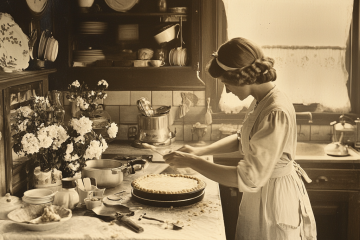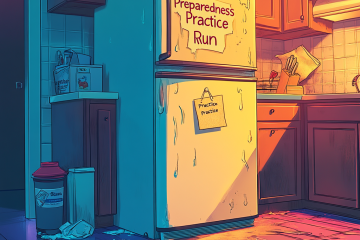What to store in your food storage?
There are 3 aspects that you need to concern yourself with when it comes to your food storage. Nutrition, preparation, and rotation.
The nutrition aspect has to do with WHAT you store. Be sure it’s not food that will simply enable you to survive, but THRIVE. Feeding your body quality nutrition in a time of stress is critical. It’s one thing to try and live off of fast food and such when you lead a mostly sedentary lifestyle. You may not think of food much now in your every day life. But having nourishment will be one of your most overriding primary instincts to kick in during a time of survival. (Yet another reason why to try and get the picky eaters in your family to expand their food repertoire.) I’ve read messages from some folks that they have a years supply in dry cereal, or Kraft Mac & Cheese, etc. While these “foods” may give some comfort immediately, they will not provide the nutrition you need and appetite fatigue will surely set in.
What should be a part of your food storage? As you plan your meals, go back to creating balanced meals. You know, fruits, vegetables, protein, and grains. Each meal you plan for your long term food storage should provide at least one serving in each of these categories. Keep in mind that you will use and require more carbohydrates in a crisis scenario than you most likely do now.
Remember, the key is to not get overwhelmed with the food storage. If I were to tell you that you needed to store 300 pounds of grains (wheat, pasta, flour, etc.) per person over the age of 7, no doubt that would stress you out and overwhelm you. (Even though that figure is correct.) This is exactly why I encourage folks to create their food storage based on meals and dishes rather than pounds. THEN when you feel like you’ve accomplished your goal in that regard, do a little bit of calculating using this food storage calculator link and see if there may be some items to add in various categories such as fats and oils, or legumes, or sugars.
If you store based on “meals” then you don’t have to really concern yourself with “oh yeah, I need 3 pounds of cinnamon for the year” or other seasonings and sauces. You will essentially have a year’s supply of menus figured out and thus you’ll have all of the seasonings you need for those dishes. Add the extras after the fact. Planning this way will also save you LOTS and LOTS of money too. You’ll be less likely purchasing something just because it looks like a good deal, and only purchase what you know you and your family will use in specific meals.
The next aspect of your food storage is preparation. Do you have the tools and resources you need to prepare the food? Do you have the recipes stored with the dishes? While it’s great that you may have recipes memorized, what if you’re ill or otherwise unavailable and aren’t the one preparing the food? Do you have a hand beater stored since you won’t be able to use an electric one? Do you know how to use your solar oven, Dutch oven, charcoal, propane stove or wood burning stove? How are you going to clean up from cooking? How are you going to ensure sanitized cooking conditions?
The last consideration of what to store in your food storage, is rotation. If you find a great deal on 30 gallons of cooking oil, great, get it—but ONLY if you already use such an oil and can do so in an appropriate period of time. Very little of your food storage should be purchased or stored with a “store it and forget it” mentality. You need to look at just about everything you’ve got from a rotation standpoint. This is a monumental task if you’re not already using what you store.
Personally, I think making an excel spreadsheet of one’s food storage or taking time to label each container of food prior to putting it away, is a major pain in the fanny and certainly yet another deterrent to being prepared. I store my food left to right, front to back, and I use it right to left and back to front. I don’t put any labels on the food (other than when I bottle or freeze it) and I don’t have a special software accounting system. As I bring things up from my food storage, I make a note on the grocery list to replace them. The “system” is as easy as that. As a result, I keep a pulse on what I have and its condition. Very little of what I have purchased over the years gets wasted this way.
As you can see in this series, the key is to make your food storage as underwhelming and second nature as your grocery shopping and meal preparations are today. Your food storage efforts just need a little tweak in your mental preparedness and you’ll find that you have the time and energy to focus on the other aspects of preparedness that may more appropriately stretch your skills and time.
UNDERwhelmed in Food Storage Series
- UNDERwhelmed in Food Storage Part 1 of 8
- UNDERwhelmed in Food Storage Part 2 of 8
- UNDERwhelmed in Food Storage Part 3 of 8
- UNDERwhelmed in Food Storage Part 4 of 8
- UNDERwhelmed in Food Storage Part 5 of 8
- UNDERwhelmed in Food Storage Part 6 of 8
- UNDERwhelmed in Food Storage Part 7 of 8
- UNDERwhelmed in Food Storage Part 8 of 8
For any questions or comments on this article, please leave a comment on the blog site so that everyone can benefit!
Copyright Protected 2009, Preparedness Pro and Kellene. All Rights Reserved. No portion of any content on this site may be duplicated, transferred, copied, or published without written permission from the author. However, you are welcome to provide a link to the content on your site or in your written works.





8 Comments
Jerry · July 19, 2009 at 7:19 pm
I would like to see articles on ramen noodles and using Datrex and Mainstay food bars in cooking. Thank you.
Jerry · July 19, 2009 at 7:19 pm
I would like to see articles on ramen noodles and using Datrex and Mainstay food bars in cooking. Thank you.
Kellene · July 20, 2009 at 9:35 pm
I’ll see what I can do for you Jerry.
Kellene · July 20, 2009 at 9:35 pm
I’ll see what I can do for you Jerry.
Kris · August 6, 2009 at 2:16 am
Do you know of a site that calculates how much you need by allowing you to plug in your recipes? Let’s say you want a 7 or 14 day menu, 52 or 26 times….. then your list. Make sense?
Kris · August 6, 2009 at 2:16 am
Do you know of a site that calculates how much you need by allowing you to plug in your recipes? Let’s say you want a 7 or 14 day menu, 52 or 26 times….. then your list. Make sense?
Kellene · August 7, 2009 at 3:51 pm
Besides the typical food storage calculators that you see online, the only thing I have found is serving alterations. For example, take a recipe from allrecipes.com. While one meal will typically produce 6 servings, times that by 26 (if it’s part of your 14 day meny) and this recipe http://allrecipes.com/Recipe/Baked-Penne-and-Smoked-Sausage/Detail.aspx says that you’ll need 16 oz of sausage, 10.75 oz of cream of mushroom soup, 64 cups of milk, 12-3/4 lbs of uncooked penne, etc. Hope that helps!
Kellene · August 7, 2009 at 3:51 pm
Besides the typical food storage calculators that you see online, the only thing I have found is serving alterations. For example, take a recipe from allrecipes.com. While one meal will typically produce 6 servings, times that by 26 (if it’s part of your 14 day meny) and this recipe http://allrecipes.com/Recipe/Baked-Penne-and-Smoked-Sausage/Detail.aspx says that you’ll need 16 oz of sausage, 10.75 oz of cream of mushroom soup, 64 cups of milk, 12-3/4 lbs of uncooked penne, etc. Hope that helps!
Comments are closed.